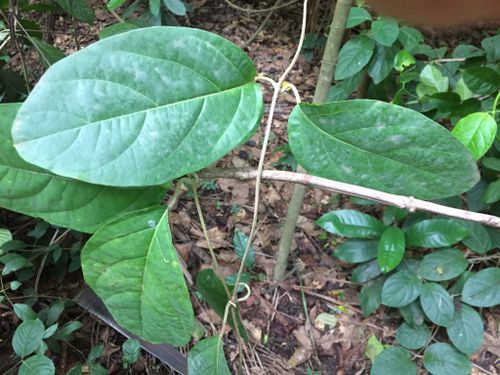Flabellaria paniculata

|
|
Flabellaria paniculata Common Names: Panicle Flabellaria, Flabellaria Vine,
West African Vine Scientific
Classification Kingdom: Plantae Clade: Tracheophytes Clade: Angiosperms Clade: Eudicots Clade: Rosids Order: Malpighiales Family: Malpighiaceae Genus: Flabellaria Species: F. paniculata Binomial Name: Flabellaria paniculata Cav. Synonyms: Triaspis flabellaria A.Juss., Triopterys pinnata Poir., Hiraea paniculata Cav. Morphological Description Flabellaria paniculata is a woody, climbing shrub or vine, reaching 3–15 m in
length with grey-silky branches. Key features include: · Stems: Lenticellate, up to 10 cm in diameter, younger stems with
dense grey or yellowish silky indumentum · Leaves: Opposite, broadly elliptic to ovate, 5–15 cm long, 4–10 cm
wide, subcoriaceous, silky-tomentose beneath · Inflorescences: Paniculate, lateral/terminal, up to 20 cm
long · Flowers: Small, white to light pink, radially symmetrical, petals
spatulate, 1 cm across · Fruits: Samaras, winged, 2–3 cm long, aiding wind dispersal Its climbing habit suits
riverine habitats (Burkill, 1997). Distribution and Habitat Flabellaria paniculata thrives in: · Native Range: Tropical Africa (Senegal to Cameroon, Congo Basin to
Uganda/Tanzania) · Habitat: Thickets, woodlands, secondary forests, riverbanks; 0–1,650
m altitude · Soil/Climate: Moist, well-drained soils; tropical, 1,000–2,500 mm rainfall It flourishes along
rivers, aiding its ecological spread (Hutchinson & Dalziel, 1958). Ethnopharmacology Flabellaria paniculata
is traditionally utilized for its medicinal properties. Phytochemical analyses
have identified bioactive compounds within the plant, including saponins,
tannins, and alkaloids, which contribute to its therapeutic potential.
Pharmacological studies have demonstrated that F. paniculata possesses
antioxidant, anti-inflammatory, anticancer, antiulcer, antifungal,
anthelmintic, and wound-healing properties. These findings support its
traditional use in treating various ailments, including skin infections,
wounds, and rheumatic pain. Traditional uses,
supported by studies, include: · Wound Healing: Leaf extracts in Nigeria/Ghana; chloroform fraction achieved
100% wound closure by day 14 in rats (Olugbuyiro et al., 2010). · Anti-inflammatory: Stem/leaf for rheumatism in Nigeria;
volatile oils reduce inflammation (Oladosu et al., 2012). · Antimicrobial: Leaves vs. S. aureus (MIC 50 µg/mL) in Nigeria (Abo & Olugbuyiro, 2004). · Antiulcer: Leaf extract in Nigeria; 82.22% lesion reduction in rats at
100 mg/kg (Sofidiya et al., 2012). · Anticancer: Root extract in Nigeria; inhibits MCF-7 breast cancer cells
(IC₅₀ 45 µg/mL) (Johnson et al., 2021). These validate its
folkloric use, though further clinical trials are needed (PROTA, 2019). ⚠ Toxicity Profile: Sub-chronic use (>500 mg/kg) impairs renal
function in rats; symptoms include tremors, refusal of feed (LD₅₀ i.p. 2,951.2
mg/kg) (Akindele et al., 2014). Additional Information · Ecological Role: Supports pollinators; seeds dispersed by
wind (Burkill, 1997). · Cultural Use: Stems for baskets/mats in Nigeria; ornamental vine (PROTA,
2019). · Other Uses: Root as snakebite antidote in Ghana (Burkill, 1997). References
External Links More Pictures |
|
| Compounds of Flabellaria paniculata | |
| References |